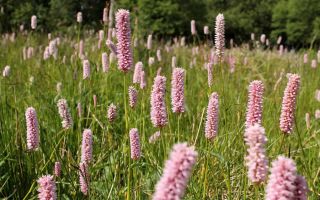Content
- 1 What it looks like and where it grows
- 2 The chemical composition of the mountaineer snake
- 3 Useful properties of the snake mountaineer
- 4 Preparation and application methods
- 5 Application of the serpentine mountaineer
- 6 Contraindications to the use of snake mountaineer
- 7 Collection and procurement
- 8 Conclusion
The beneficial properties of the mountaineer snake are used in the treatment of digestive ailments and inflammations. Traditional medicine uses the plant to create decoctions and infusions with strong healing and tonic qualities.
What it looks like and where it grows
Snake mountaineer, crayfish necks, or large serpentine (Bistorta officinalis), is a herbaceous perennial plant of the Buckwheat family. It has a straight, slightly branched stem up to 1.5 m in height and a thick curved dark red root with folds on the surface.
The leaves of the snake knotweed are arranged in regular order on the petioles, longer at the bottom and short at the top. The plates are oblong or lanceolate in shape with slight waviness along the edge. The upper surface of the leaves is green, below they are glaucous.
From May to June, the snake highlander produces dense, spike-shaped inflorescences, consisting of small, pale pink, red or white buds. The fruits of the plant are brown triangular nuts with a smooth and shiny surface.
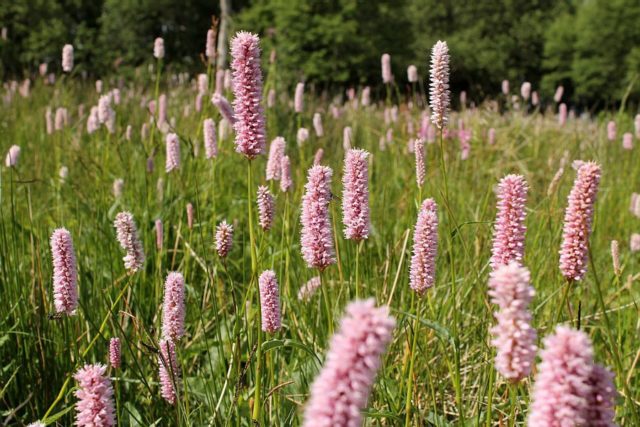
Highlander is widespread in the temperate climate of the Northern Hemisphere, it is found in the European part of Russia and Siberia, grows in steppe zones, forests and tundra. It chooses moist, slightly acidic soils and well-lit places for life, develops on peat and floodplain meadows and along the banks of water bodies.
The chemical composition of the mountaineer snake
Interest in photography and the healing properties of serpentine herb is due to its chemical composition. The roots and green parts of the plant contain:
- tannins - up to 25%;
- starch;
- vitamin C;
- rutin and avicularin;
- dyes;
- provitamin A;
- calcium oxalate;
- free polyphenols;
- catechin;
- gallic acid;
- flavonoids;
- hyperoside;
- oxyanthraquinones;
- elaidic acid.
Due to its rich composition, the snake mountaineer has good healing, anti-inflammatory and hemostatic qualities.
Useful properties of the snake mountaineer
Snake mountaineer, when used carefully, brings great benefits to the body. Namely:
- helps to cope with diarrhea and dysentery;
- dissolves small stones in the gallbladder;
- has a calming effect on the nervous system;
- stops bleeding and helps with hemorrhoids;
- improves heartburn;
- removes swelling and eliminates toxins and toxins;
- soothes irritated mucous membranes of the mouth;
- helps to cope with the consequences of poisoning;
- promotes healing of wounds, ulcers and cuts;
- prevents the development of anemia and vitamin deficiency;
- strengthens the immune resistance.
Means based on the snake mountaineer are used in the complex treatment of prostatitis and rectal cancer.
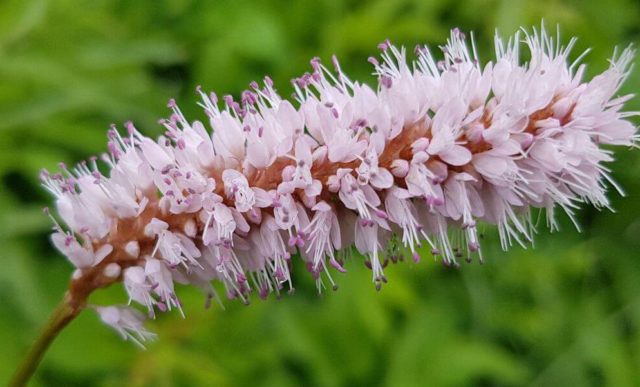
Healing properties of snake highlander root
The root of the snake knotweed contains especially a lot of tannins.Funds based on it are used for intestinal disorders - diarrhea, dysentery, poisoning. Herbal raw materials have a fixing effect and normalize stool, as well as help restore microflora and soothe pain.
Preparation and application methods
Traditional medicine prepares medicinal decoctions and strong tinctures on the basis of the coil herb. Means made in accordance with recipes have pronounced healing properties and retain a maximum of useful substances in their composition.
Highlander serpentine tincture
Tincture of snake mountaineer is taken internally and externally for inflammation and digestive disorders. The recipe for the preparation of the drug looks like this:
- The dried rhizomes are finely chopped and 100 g of raw material are poured into a glass container.
- Pour 500 ml of medical alcohol with a strength of 70%.
- Put away in a dark place for two weeks.
- Filtered when ready.
Inside the tincture is taken on an empty stomach, 30 drops. To prevent the strong product from burning the mucous membranes, it is recommended to dilute it with water first.
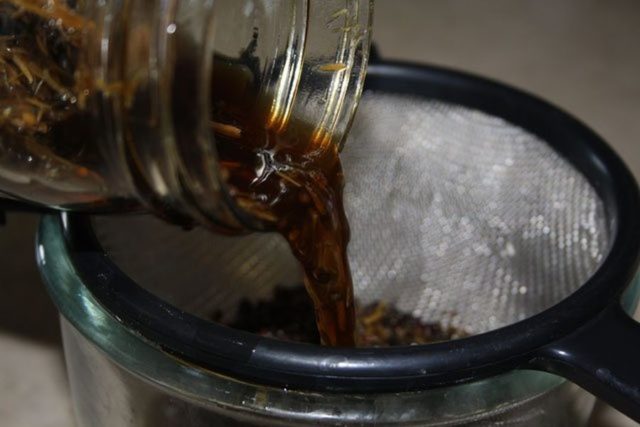
Infusion
An infusion of snake knotweed root helps with diarrhea, peptic ulcer disease and bleeding. It is prepared according to a simple recipe:
- Dry raw materials are chopped with a knife or with a blender.
- Pour 100 g of the resulting powder into a thermos and pour 1 liter of boiling water.
- Close the lid and leave for eight hours.
- Filter from sediment.
Take the drug 15 ml up to four times a day. The infusion works most quickly when consumed on an empty stomach.
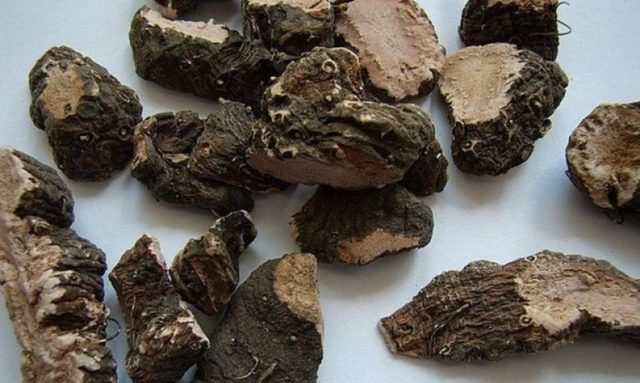
Decoction
For stomach ulcers and duodenal ulcers, as well as for dysentery and urethritis, a decoction of the snake knotweed is recommended for use. It has strong anti-inflammatory and healing properties, promotes tissue repair and fights bacterial processes.
A decoction is prepared according to the following algorithm:
- The dry root of the snake mountaineer is crushed to obtain 200 g of a homogeneous powder.
- Pour raw material with 2 liters of water in a large saucepan.
- Bring to a boil on the stove and heat over low heat for 20 minutes.
- Cool under a lid and filter through cheesecloth.
The broth should be taken on an empty stomach four times a day in a large spoon.
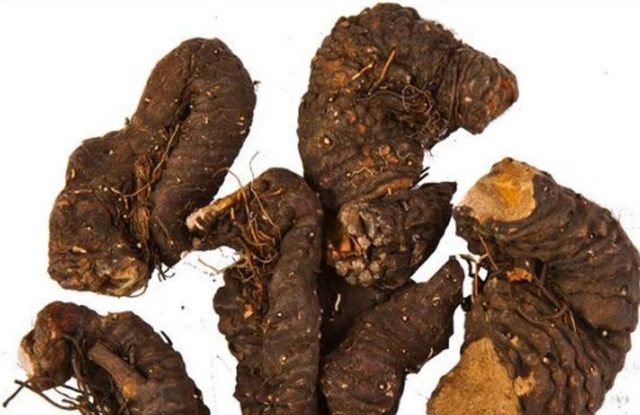
Application of the serpentine mountaineer
In folk medicine, the coil is used alone or together with other medicinal plants for chronic and acute diseases. There are several recipes to make the most of the herb's healing properties.
With gastritis
Snake mountaineer soothes irritated mucous membranes and relieves heartburn and heaviness in the stomach. For medicinal purposes, you can prepare the following collection:
- The roots of the coil are crushed in a volume of 15 g.
- Raw materials are mixed with an equal amount of dried mint, St. John's wort and Icelandic moss.
- Measure out two large spoons of the collection and steamed 300 ml of fresh boiling water.
- Leave covered for two hours.
The filtered drink is consumed 100 ml three times a day. To obtain the maximum effect, treatment is continued for at least a month.
With stones in the gall
Serpentine knotweed in combination with other plants accelerates the outflow of bile and promotes the destruction and excretion of small calculi. Healing broth is done like this.
- The roots of the snake mountaineer in a volume of 10 g are mixed with a similar amount of corn stigmas, St. John's wort and wormwood.
- Add 10 g of yarrow, dandelion roots, budra and turnip.
- 10 g of rose hips, volodushka and dill seeds are introduced.
- Components are properly crushed and mixed.
- Measure 30 g of the collection and pour 1 liter of water.
- Bring the product to a boil, and then heat it up for half an hour over low heat.
Filter the finished broth and drink half a glass up to four times a day.
With intestinal colic and diarrhea
Snake knotweed is good for any intestinal disorders. The following infusion is prepared for treatment:
- A large spoonful of crushed root is poured with 200 ml of hot water.
- Leave in a thermos for 6-8 hours.
- After the time has elapsed, filter the drink.
You need to use the infusion three times a day, a large spoonful.
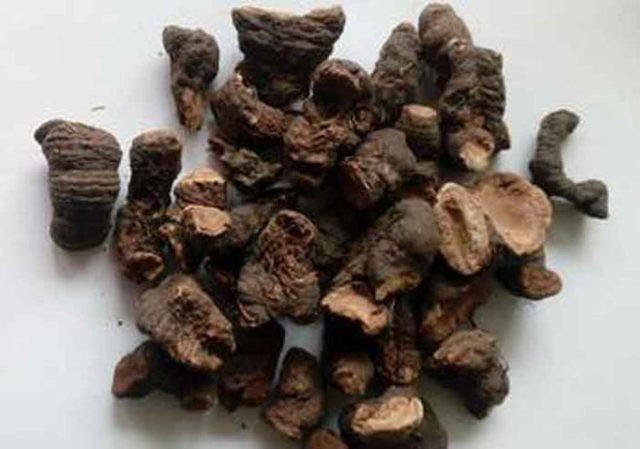
For ulcers and boils
It is possible to use the snake knotweed for inflammatory skin ailments by external methods. A decoction is prepared for treatment:
- Finely cut dry roots, measure 15 g and steam with 500 ml of boiling water.
- The solution is heated on the lowest heat for 20 minutes.
- Remove from the stove and leave under the lid for an hour.
- Strain through cheesecloth.
In a warm product, it is necessary to moisten a piece of tissue and apply a compress to the sore spot for at least 20 minutes. It is necessary to treat ulcers and suppurations with a snake mountaineer three times a day.
With bleeding gums
The medicinal coil relieves inflammation in dental diseases, accelerates the healing of the gums and eliminates pain. Traditional medicine suggests preparing a rinse solution:
- Dry roots in the volume of four small spoons are poured with a glass of boiling water.
- Keep the product covered for at least 20 minutes.
- Pass through cheesecloth for filtration.
Warm infusion should be rinsed up to six times a day.
With radiculitis
An ointment based on snake knotweed and other medicinal herbs is beneficial for lumbar lumbago. It is prepared according to the following algorithm:
- The roots of the coil, pine buds and celandine herb are mixed in 10 g each.
- Add a similar amount of eucalyptus and mint leaves.
- Grind the ingredients to a homogeneous powder.
- Measure 40 g of raw materials and pour 150 ml of boiling water.
- Simmer over low heat for five minutes.
- Add 70 g of pork fat to the mixture for melting.
When the product acquires a viscous semi-liquid consistency, you need to cool it and put it in the refrigerator until it solidifies. Ointment from the snake mountaineer is applied to sore spots, lightly rubbing into the skin, and insulated on top with a bandage and a woolen scarf.
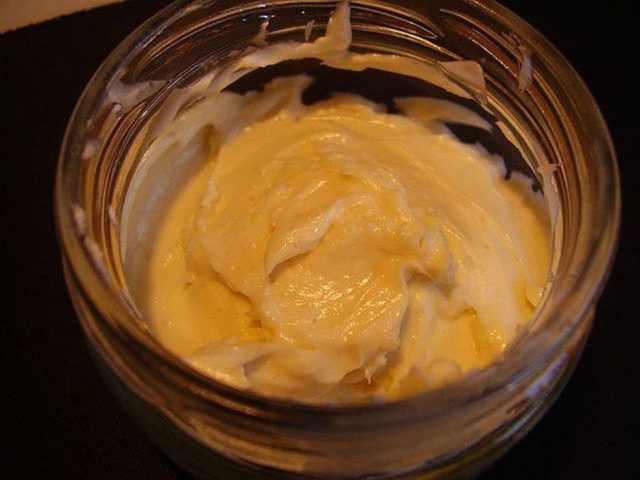
With impotence
The healing properties of the crayfish plant have a positive effect on male potency. When libido is weakened, it is recommended to prepare a healing mixture of several herbs:
- An equal amount of calendula, celandine, barberry and rose hips are added to 10 g of the snake mountaineer.
- 10 g of parsley, lemongrass, wormwood and St. John's wort are introduced.
- Add a similar amount of dandelion and wintergreen herb.
- Brew 30 g of the drug mixture with 500 ml of hot water.
- Insist for half an hour closed.
The ready collection is filtered and taken up to four times a day, 250 ml each. It is necessary to continue treatment for two weeks.
With bleeding
The tannins in the coil help stop hemorrhoids, uterine and other internal bleeding. Traditional medicine advises the following decoction for use:
- Crushed rhizomes in a volume of 20 g are poured with 200 ml of liquid.
- Sent to a water bath for half an hour.
- Remove from heat and insist closed for 45 minutes.
- Filter and add clean water to the initial volume.
For medicinal purposes, the broth is consumed before meals three times a day, 15 ml each until you feel better.
For gynecological infections
The anti-inflammatory properties of the snake mountaineer accelerate the cure of urinary infections and cystitis, and help with fungal diseases. For therapy, you need to prepare an infusion:
- Finely chop dry roots, measure 15 g and pour in 500 ml of fresh boiling water.
- Leave for an hour under a lid and towels.
- After the expiration of the period, filter.
In a warm form, the infusion is used for douching twice a day. In total, treatment is recommended for at least ten days.
For wounds and cuts
Snake mountaineer has strong disinfecting properties and helps to avoid inflammation in case of skin damage. They use it practically without additional processing:
- Grind the rhizomes of the plant to obtain 15 g of dry powder.
- Sprinkle the remedy on the sore spot.
- Cover with a bandage for 20 minutes.
When applied three times a day, Coil Root Powder will accelerate tissue repair and prevent scarring.
Contraindications to the use of snake mountaineer
The valuable properties of coil grass are not the same for everyone. It is necessary to refuse the use of drugs based on a cancerous cervix:
- with increased acidity of the stomach;
- with individual allergies;
- with a tendency to constipation;
- during pregnancy and lactation.
Decoctions and infusions of a medicinal plant are not offered to children under two years of age. When using medicinal products, dosages must be observed, otherwise side effects will appear - abdominal pain, nausea, vomiting and dizziness.
Collection and procurement
For medicinal purposes, mainly the rhizomes of the snake mountaineer are used. They are dug out of the ground from August to October after the ground part of the plant dies off. You can also pick the coil in early spring, before the stems and leaves are growing.
Rhizomes are completely removed from the ground, small shoots are removed and the raw material is washed from the rest of the soil. Next, you need to cut the plant into pieces about 10 cm long and spread out to dry in the open air or indoors. It is also allowed to use a dryer or oven, but the temperature should not exceed 45 ° C. When moisture has completely evaporated from the roots of the coil, they will need to be poured into a glass jar or paper bag and put in a dark and cool cabinet.
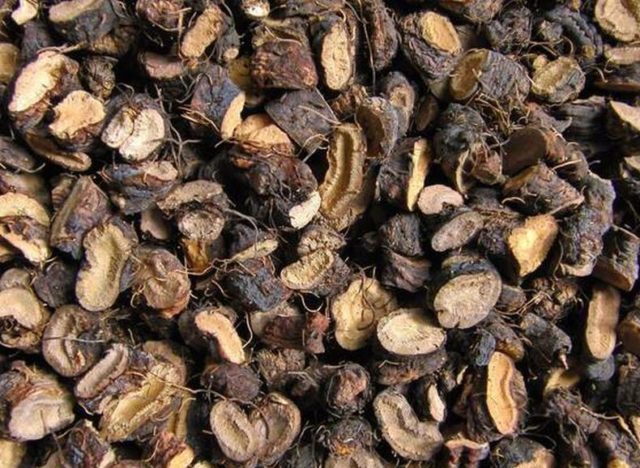
Conclusion
The beneficial properties of the mountaineer snake are especially often used for diarrhea and dysentery. Also, the plant can stop bleeding and promotes rapid healing of ulcers and erosions. The coil rarely causes harm, but requires adherence to dosages.

